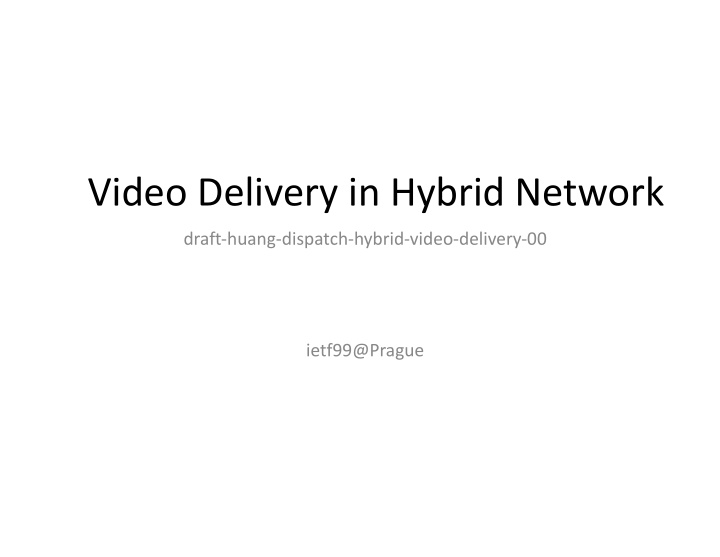



Video Delivery in Hybrid Network draft-huang-dispatch-hybrid-video-delivery-00 ietf99@Prague
Multiplatform Distribution for Video Some use cases for video distribution in multiplatform environment Non IP based , e.g, cable/satellite IP fixed Ethernet IPTV STB network Wifi Video TCP/ IP Headend CDN Source UDP (uni/multi- IP mobile Tablet/ cast) network Phone 3G/4G Use case 1: Operator’s hybrid video delivery IP fixed Ethernet IPTV STB network Wifi Multicast/ OTT LIVE Gateway CDN Unicast IP mobile Tablet/ network 3G/4G Phone Use case 2: OTT video hybrid delivery
The Diversity on IP Distribution Encoding Protection Streaming View Packaging Distribution § MPEG2 § CA § HTTP § STB § DASH § Multicast § H.264 § DRM § RTP § iOS § HLS § Unicast § HEVC § CENC § Android § ABR § VP8/9 § PC Overall • Design, deployment, test and operational complexity are increased • Multiple device protocol stacks: Multicast, Unicast, Adaptive bit rate • May involve multiple roles: content provider, network service providers, CDNs, etc.
Looking into the Transport Protocols File Mode Packet Mode • Unicast supports both PULL Mode PUSH Mode “PULL mode” and “PUSH mode”. • Multicast only Codecs 0 supports “PUSH mode”. • “PULL mode” only ISOBMFF/MPEG-2 TS Codecs/TS supports “File mode” content. HTTP NORM/FLUTE RTP • “PUSH mode” supports content for both “File mode” and TCP/IP UDP “Packet mode” IP
Impact of the Diversity • File mode is usually done in “PULL mode”. •For “PUSH mode” p It usually uses reliable transport protocols like NORM, FLUTE. p It usually implies methods like retransmission to recover lost data, but sacrifices low latency. Whether it can satisfy some service with strict latency requirements is a open question. • Another way to transport in “PUSH mode” is to convert “File mode” into “Packet mode” p It’s suitable for applications that can tolerate certain packet loss, so that latency requirement can be satisfied. p To do so, a gateway is needed to take out the container and extract the codecs to fit in the content aware protocols like RTP. p Problem is that the gateway should be authorized to do so, and may need to deal with media protection issues. p Another problem is that it is difficult to converted back to “FILE mode” again.
What the IETF can do? • MPEG has some efforts to provide convergence for this diversified situation in common format level, e.g., MMT, CMAF but this is more for file mode (we can simple transfer MMT over RTP but is it a good enough solution?) • Do we want to work on convergence of file and packet mode. • Is some content agnostics application level transport method should be developed in IETF? • If there is interest we can start discussing the issue offline during this week.
Recommend
More recommend